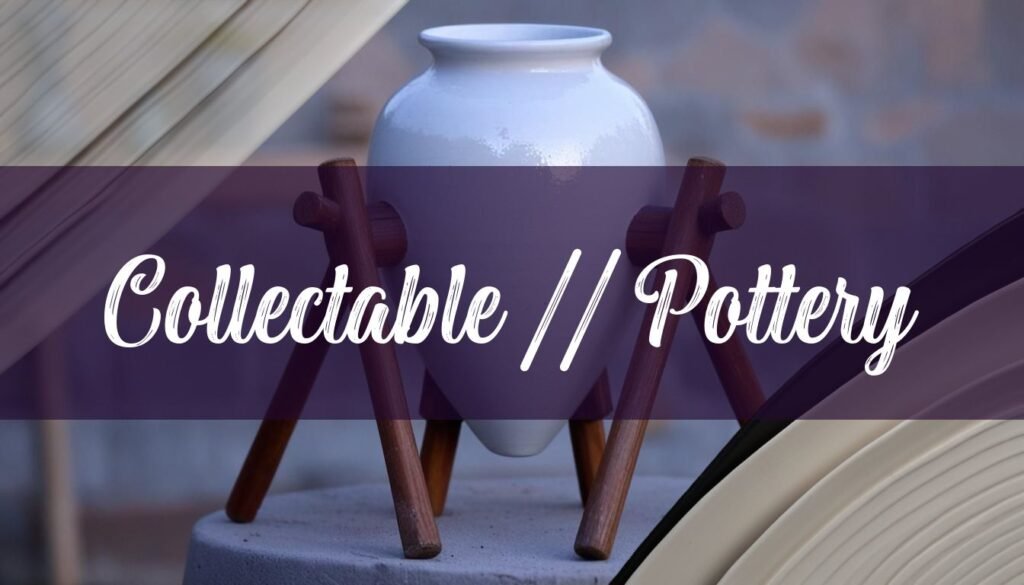What is the most collectable pottery? The world of collectible pottery is a vast and fascinating landscape, attracting enthusiasts and investors alike. Determining what makes a piece of pottery “collectible” involves a complex interplay of factors, including rarity, historical significance, the reputation of the maker, and, of course, its condition. Exploring these elements will help both novice and seasoned collectors navigate the market and build collections that are not only valuable but also personally rewarding. Pottery, as one of mankind’s earliest inventions, dating back to 29,000 BCE, holds enduring influence, functionality, and artistic value throughout millennia ( as one of mankind’s earliest inventions ). Like any antique, pottery helps to tell a story of a bygone age, and your specific item could have been used by countless people over the course of many decades and perhaps even centuries ( helps to tell a story of a bygone age ). Each of these aspects contributes to the value and collectibility of pottery, making it a rich and diverse field for collectors.
Factors Influencing Collectibility
Rarity stands as a cornerstone of collectibility. Pieces produced in limited quantities, those with few remaining examples, or items featuring unusual shapes and sizes often command higher prices ( often command higher prices ). The older a piece, the more valuable it can be, especially if it originates from a historically significant period or culture ( The older a piece, the more valuable it can be ). Historical significance adds another layer of value. Pottery can offer insights into past societies, their technologies, and their artistic sensibilities ( offer insights into past societies ). Items with unique patterns, like old China pottery, often featuring bright, gold detailing with flowers and rivers, stand out and enhance their historical appeal ( enhance their historical appeal ). The maker’s mark or artist’s signature is a critical indicator of value and authenticity ( critical indicator of value ). Renowned manufacturers like Wedgwood, Royal Doulton, and Derby carry significant prestige in the pottery world ( carry significant prestige ). The reputation of the company or artist greatly influences a piece’s desirability and market value ( influences a piece’s desirability ). Condition plays a pivotal role in determining a piece’s value ( pivotal role in determining a piece’s value ). Items in mint condition, free from chips, cracks, or repairs, typically command a premium ( typically command a premium ). Even minor damage can significantly reduce the value, although well-restored items can still hold considerable worth ( can still hold considerable worth ). Provenance, the documented history of a piece, can greatly enhance its value ( can greatly enhance its value ). Knowing who owned the pottery, where it was found, and its exhibition history can add to its story and desirability ( add to its story and desirability ). Documentation like a Certificate of Authenticity (COA) or purchase receipts help in appraisal ( help in appraisal ). Exploring European Majolica history, design, and influence offers additional context for collectors interested in historical pieces.
Specific Types and Renowned Makers
Several pottery types and manufacturers are particularly prized among collectors. Wedgwood, an English fine china and porcelain company founded in 1895, is celebrated for its iconic Jasperware, featuring unglazed exteriors and classical Roman or Greek figures ( celebrated for its iconic Jasperware ). Its rapid success made it one of the largest manufacturers of Staffordshire pottery ( one of the largest manufacturers ). Rookwood Pottery, an American company, produced decorative art pottery highly sought after by artisans and architects ( highly sought after ). Its recent resurgence in collector admiration makes it a key area of interest ( key area of interest ). Antique Asian ceramics, especially from China, are some of the most valuable due to their age and rich history ( some of the most valuable ). Pieces from dynasties like Ming, Song and Kangxi are particularly esteemed, showcasing intricate, hand-painted designs and unique glazes ( particularly esteemed ). Contemporary studio pottery is also gaining traction, with collectors drawn to innovative designs and techniques employed by modern ceramic artists ( gaining traction ). Artists like Grayson Perry, Lucie Rie, and Peter Voulkos have significantly influenced the field, bridging the gap between fine art and ceramic crafts ( significantly influenced the field ). Other notable pottery types include Staffordshire figures, antique mochaware, spongeware, agateware, Blackware, Spatterware, and Basalt pottery ( notable pottery types ). Each offers unique aesthetic qualities that appeal to different collectors ( unique aesthetic qualities ). Vintage floral patterns, reminiscent of Alcobaça ceramics, are making a comeback, and hand-painted ceramics are experiencing a revival, reflecting a cultural shift towards pieces evoking memories of bygone eras ( making a comeback ). The Arts and Crafts pottery movement also provides a fascinating area for collectors interested in timeless beauty.
Resources for Collectors
Identifying, authenticating, and appraising collectible pottery requires access to reliable resources. Auction houses like Christie’s, Sotheby’s, Bonhams, and Rago Auctions are excellent venues for buying and selling high-value pieces ( excellent venues ). They offer expert appraisals and historical context, ensuring informed transactions ( ensuring informed transactions ). Online databases such as The Mark’s Project and Antique Marks provide visual references for identifying maker’s marks and signatures ( visual references ). These tools help collectors verify the origin and authenticity of their pieces ( verify the origin and authenticity ). Collector communities and forums, including those on Reddit ( r/Pottery , r/studiopottery) and 20th Century Forum, offer platforms for sharing knowledge, seeking advice, and connecting with other enthusiasts ( sharing knowledge ). Consulting with experienced appraisers is crucial for determining the value of a collection or individual piece ( crucial for determining the value ). Organizations like the National Auctioneers Association (NAA), International Society of Appraisers (ISA), and Appraisers Association of America (AAA) provide directories of qualified professionals ( directories of qualified professionals ). The Antiques Roadshow website also offers an appraiser directory searchable by location and specialty ( appraiser directory ). Finally, staying informed about current trends is essential. Emerging interests in mid-century modern ceramics, folk art, and vintage-inspired designs reflect evolving tastes in the market ( evolving tastes ). By combining knowledge, resources, and a passion for the craft, collectors can build valuable and personally fulfilling pottery collections.





